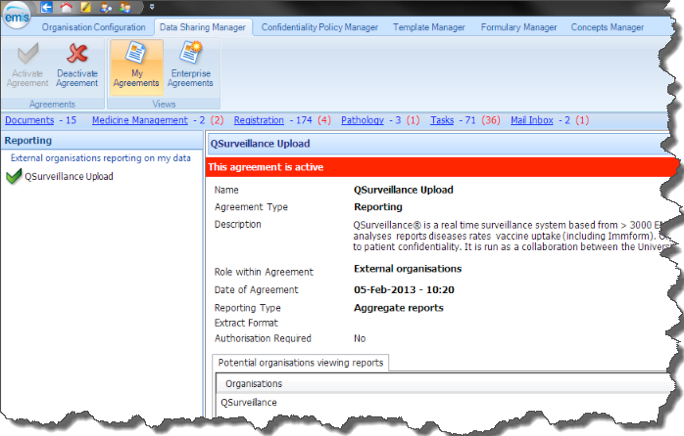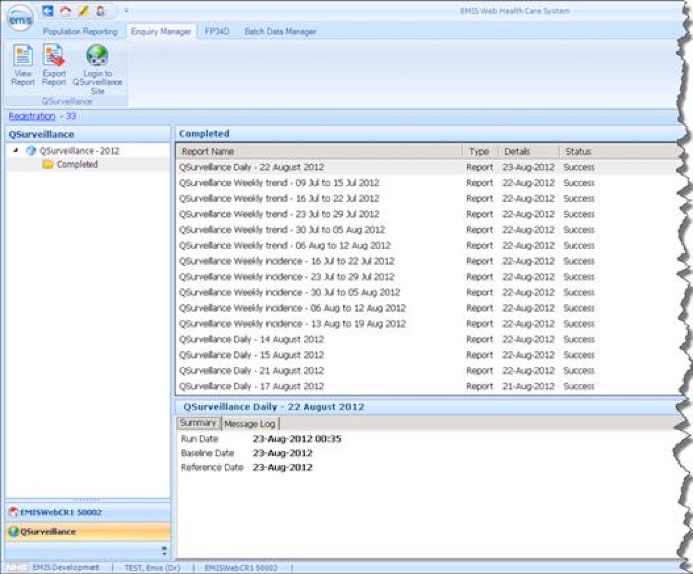We are pleased to invite EMIS WEB practices to join QSurveillance®.
What is QSurveillance®?
QSurveillance® is a near real time surveillance scheme which will collects, analyses and reports of rates of infectious diseases and vaccine uptake (flu, pneumococcal, DTaP/IPV/Hib, MMR, shingles, prenatal pertussis, Hepatitis B, meningitis ACWY, rotavirus and COVID-19 vaccination).
QSurveillance® has the capability of providing timely data in the face of emerging public health problems (e.g. flu epidemic or gastroenteritis which could result from widespread flooding). It was used to provide critical information during the recent swine flu pandemic in 2009. QSurveillance® can also respond to chemical incidents, concerns about safety of medication or report in extreme weather conditions (e.g. during a heat wave) to help estimate the scale of the problem and plan a response.
QSurveillance® summary data has also been designed so that it can rapidly assess the safety and effectiveness of new medications (for example, a newly developed flu vaccine developed rapidly during a pandemic or where there is an unexpected public health issue).
Who is running QSurveillance® and who is the clinical custodian?
QSurveillance® is run as a collaboration between the University of Oxford and EMIS Health . The development of QSurveillance® originated from the QResearch database.
Professor Julia Hippisley-Cox (Professor of Clinical Epidemiology and General Practice at the University of Oxford and former medical director of ClinRisk Ltd) is the clinical custodian of the summary data. The scheme is supported by the EMIS National User Group and the British Medical Association.
Following the move of the key member of Professor Julia Hippisley-Cox from the University of Nottingham to the University of Oxford, EMIS has been working with Oxford, Public Health England and others, in relation to the ongoing delivery of the QSurveillance service. Further information will be posted here in due course in relation to any proposed changes.
If you are a practice contributing to QSurveillance®, or would like to contribute, and have any questions please email julia.hippisley-cox@phc.ox.ac.uk
What data is extracted and analysed?
QSurveillance® only extracts summary data which is aggregated by age and sex (ie counts of patients who have the conditions of interest in a given time period). For vaccine uptake data submitted to Immform, there is also an additional breakdown of the total number of people in each ethnic group who are eligible for a vaccine and who have had a vaccine. This is not subdivided by age and sex.
No individual patient data is extracted. There is no risk to patient confidentiality. The reports are run at midnight each night and extracted onto a central server at EMIS and from there to a secure server based in Oxford University.
What indicators are included in QSurveillance®?
The indicators which are currently included in QSurveillance® can be found on the indicators page of this website. These are likely to evolve in response to developing needs for public health surveillance. This list will be revised accordingly.
How are decisions about additional data taken and implemented?
Professor Julia Hippisley-Cox is the clinical custodian of QSurveillance® responsible to the practices, profession and the public for use and disposition of QSurveillance® data. In the event of an unexpected urgent public health situation requiring increased surveillance, we will discuss the additional data items with the relevant government authority. For example, for infectious disease or chemical incidents, this will be Public Health England. For medication safety it will be the Department of Health or Medicine Health Regulatory Authority.
Representatives of the University of Oxford, BMA, EMIS and the National EMIS User Group will be consulted and Trent MREC where appropriate. The additional indicators will be added to the table on the website which lists all the current indicators.
The EMIS patch system will be used to notify practices of the reason for the extraction (for example, the floods in the South West) and the additional data items needed in advance of the extraction. Practices can opt out at any point without giving a reason.
All analyses will be independently undertaken, scientifically reviewed where appropriate and publically available in accordance with our research governance framework.
Is there any risk to practice or patient confidentiality?
No patient level data or identifiable data is extracted and there is no risk to patient confidentiality. As an additional safeguard, we suppress counts where there are fewer than 5 patients in an age/sex cell.
No practices can or will be identified in published reports since only summary data are reported and the identity of practices contributing data to QSurveillance® is not released to Public Health England. Reports at CCG level are only produced where there are at least 3 practices contributing data to the QSurveillance® database.
We analyse and report on other data for infectious diseases at CCG level and summary reports will be sent to Public Health England for inclusion in their weekly or daily bulletins, which are at
https://www.gov.uk/government/publications/gp-in-hours-bulletin
Information on uptake of vaccine by risk category is submitted to the Public Health England via Immform. https://www.gov.uk/government/collections/immform
This information is practice identifiable and is used to monitor the uptake of vaccines during infectious disease outbreaks e.g. during seasonal or pandemic flu though no practice identifiable data is shared with third parties.
How is QSurveillance funded?
QSurveillance® receives funding from Public Health England for the vaccine uptake reports.
Do practices receive any payments for taking part in QSurveillance?
Practices are not paid for taking part and do not need to pay to join. The data are not used to determine practice payments or measure performance. Practices contributing to QSurveillance® are able to compare their practice indicators with other anonymised practices via the QFeedback Practice Portal.
Consenting and activating QSurveillance in EMIS Web
If you are an EMIS Web practice that would like to contribute to QSurveillance®, please activate the agreement in Data Sharing Manager.
To activate QSurveillance® transmissions:
- Access Data Sharing Manager in one of the following ways:
- Click
 , point to Configuration, and then click Data Sharing Manager.
, point to Configuration, and then click Data Sharing Manager. - If you have customised the quick access toolbar, click
 .
. - If you are already in the Configuration module, click the Data Sharing Manager tab at the top of the screen, or press ALT and then press S.
- From anywhere else in the system, press ALT, press E, press Z, and then press S.
- On the homepage, click the link, if configured.
- Click
- With the Data Sharing Manager screen active:
- click My Agreements.
- In the navigation pane, select the QSurveillance® agreement, and then
- select Activate Agreement on the ribbon.
QSurveillance® transmissions are now activated. If you wish to stop them at any time, select the Deactivate Agreement ribbon option.

Data Sharing Manager screen with QSurveillance agreement activated
Note: To access Data Sharing Manager, you must have Role Based Access Control (RBAC) activity B0109 – Local Restricted System Administration in your role profile (configured in Organisation Configuration). For more information about RBAC, refer to UG148 EMIS Web Organisation Configuration.
To view QSurveillance® reports in EMIS Web, do the following:
- Access Enquiry Manager in one of the following ways:
- Click , point to Reporting, and then click Enquiry Manager.
- If you have customised the quick access toolbar, click .
- If you are already in Reporting, click the Enquiry Manager tab, or press ALT and then press Q.
- From anywhere else in the system, press ALT, press E, press S, and then press Q.
- On the homepage, click the link, if configured.
- The Enquiry Manager screen is now displayed.
- In the navigation pane, select the QSurveillance tab.
- The QSurveillance® reports are now displayed.

Enquiry Manager screen with QSurveillance reports displayed
If you are having problems activating QSurveillance in your EMIS Web system, contact 0845 122 2333.
If you have any other queries about QSurveillance®, email the following with your CDB number qsurveillance@qsurveillance.org.
If you decide at any stage that you no longer wish to take part in QSurveillance®, then you can simply deactivate your system without having to give any reason. This will take immediate effect.
